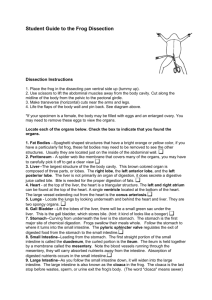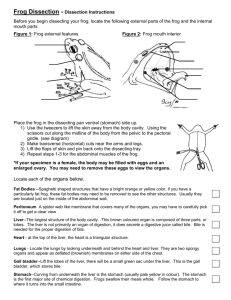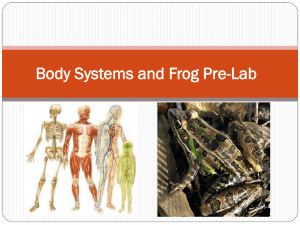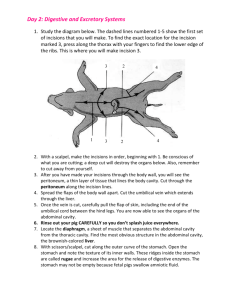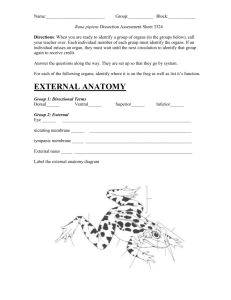Skin - SMIC Biology
advertisement
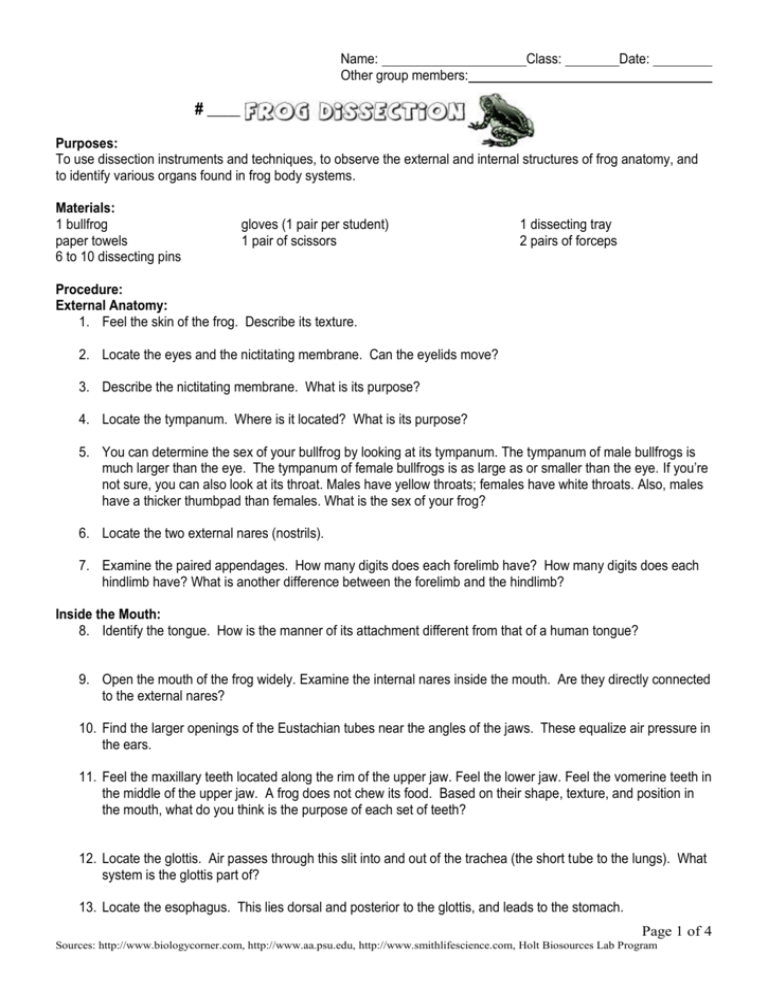
Name: Other group members: Class: Date: # ____ Purposes: To use dissection instruments and techniques, to observe the external and internal structures of frog anatomy, and to identify various organs found in frog body systems. Materials: 1 bullfrog paper towels 6 to 10 dissecting pins gloves (1 pair per student) 1 pair of scissors 1 dissecting tray 2 pairs of forceps Procedure: External Anatomy: 1. Feel the skin of the frog. Describe its texture. 2. Locate the eyes and the nictitating membrane. Can the eyelids move? 3. Describe the nictitating membrane. What is its purpose? 4. Locate the tympanum. Where is it located? What is its purpose? 5. You can determine the sex of your bullfrog by looking at its tympanum. The tympanum of male bullfrogs is much larger than the eye. The tympanum of female bullfrogs is as large as or smaller than the eye. If you’re not sure, you can also look at its throat. Males have yellow throats; females have white throats. Also, males have a thicker thumbpad than females. What is the sex of your frog? 6. Locate the two external nares (nostrils). 7. Examine the paired appendages. How many digits does each forelimb have? How many digits does each hindlimb have? What is another difference between the forelimb and the hindlimb? Inside the Mouth: 8. Identify the tongue. How is the manner of its attachment different from that of a human tongue? 9. Open the mouth of the frog widely. Examine the internal nares inside the mouth. Are they directly connected to the external nares? 10. Find the larger openings of the Eustachian tubes near the angles of the jaws. These equalize air pressure in the ears. 11. Feel the maxillary teeth located along the rim of the upper jaw. Feel the lower jaw. Feel the vomerine teeth in the middle of the upper jaw. A frog does not chew its food. Based on their shape, texture, and position in the mouth, what do you think is the purpose of each set of teeth? 12. Locate the glottis. Air passes through this slit into and out of the trachea (the short tube to the lungs). What system is the glottis part of? 13. Locate the esophagus. This lies dorsal and posterior to the glottis, and leads to the stomach. Page 1 of 4 Sources: http://www.biologycorner.com, http://www.aa.psu.edu, http://www.smithlifescience.com, Holt Biosources Lab Program Internal Anatomy: 14. Place the frog in the dissecting pan ventral side up. 15. Use your fingers to lift the skin away from the body cavity. Make an initial cut, then cut along the midline of the body from between the hindlimbs to between the forelimbs. 16. Make horizontal cuts near the forelimbs and the hindlimbs. 17. Lift the flaps of the body and fold the skin back. 18. Observe the texture of the skin. What do you notice about the inside surface of the skin? 19. Pinch, lift, and cut through the muscles (not too deeply!) and stiff breast bone (no ribs or diaphragm!) to open up the body cavity. You may need to cut higher than you think. Look underneath as you cut to avoid damaging organs. If your specimen is female, the body may be filled with eggs and an enlarged ovary. You may need to push these aside to view the organs. 20. Do not remove any organs until you have already identified them. Look at the diagram (and check off each organ) on the next page as you remove each layer: Layer 1: liver and heart Liver – large, brown, composed of three lobes, covers most of the body cavity Heart – small, triangular, anterior to the liver, between the forelimbs – Can you differentiate between the two atria and the single ventricle? Layer 2: lungs Carefully remove the gall bladder and most of the liver to reveal layer 2. Watch for blood if you remove the heart Lungs – on either side of the heart, observe the alveoli and capillaries when inflated Layer 3: gall bladder, stomach, intestines Gall bladder – small, greenish sac under the liver Stomach – large, firm sac on the left side of the frog Pancreas – long, thin, and flat, directly below the stomach, attached along the small intestine Small intestine – long, tube-like organ directly posterior to the stomach, folds are held in place by a thin, transparent tissue called the mesentery Spleen – small, reddish brown organ in the mesentery Large intestine – small intestine connects to this wider tube, may be filled with feces Page 2 of 4 Sources: http://www.biologycorner.com, http://www.aa.psu.edu, http://www.smithlifescience.com, Holt Biosources Lab Program Layer 4: kidneys Kidneys – oval, brown organs in the lower part of the abdomen 21. Use the diagram below to locate and identify the organs in your frog. 22. Check each as you find each organ. Fat Bodies – Light-colored structures with finger-like protrusions attached to the ovaries or testes. If you have a particularly fat frog, these may need to be removed to see the other structures. Usually they are seen protruding from the sides of the abdominal cavity Peritoneum A spider web-like membrane that covers many of the organs; you may have to carefully peel it off to get a clear view. Liver--The largest structure of the the body cavity. This brown-colored organ is composed of three parts, or lobes. The right lobe, the left anterior lobe, and the left posterior lobe. The liver is not primarily an organ of digestion, it does secrete a digestive juice called bile. Bile is needed for the proper digestion of fats. Heart - at the top of the liver, the heart is a triangular structure. The left and right atrium can be found at the top of the heart. A single ventricle located at the bottom of the heart. Lungs - Locate the lungs by looking underneath and behind the heart and liver. They are two spongy organs. Gall bladder - Lift the lobes of the liver, there will be a small green sac under the liver. This is the gall bladder, which stores bile. Stomach - Curving from underneath the liver is the stomach. The stomach is the first major site of chemical digestion. Frogs swallow their meals whole. Follow the stomach to where it turns into the small intestine. Small Intestine - Leading from the stomach. The first straight portion of the small intestine is called the duodenum, the curled portion is the ileum. The ileum is held together by a membrane called the mesentery. Note the blood vessels running through the mesentery; they carry absorbed nutrients away from the intestine. Absorption of digested nutrients occurs in the small intestine. Large Intestine - As you follow the small intestine down, it will widen into the large intestine. The large intestine is also known as the cloaca in the frog. The cloaca is the last stop before wastes, sperm, or urine exit the frog’s body. (The word "cloaca" means sewer) Spleen - Return to the folds of the mesentery. This dark red spherical object serves as a holding area for blood. Esophagus - Return to the stomach and follow it upward, where it gets smaller is the beginning of the esophagus. The esophagus is the tube that leads from the frog’s mouth to the stomach. Open the frog’s mouth and find the opening of the esophagus. Page 3 of 4 Sources: http://www.biologycorner.com, http://www.aa.psu.edu, http://www.smithlifescience.com, Holt Biosources Lab Program STOP! If you have not located each of the organs above, do not continue on to the next section. 23. Removal of the Stomach: Cut the stomach out of the frog and open it up lengthwise. Look at the texture of the stomach on the inside. What did you find in the stomach? Describe the inside lining of the stomach. 24. Measuring the Small intestine: Remove the small intestine from the body cavity and carefully separate the mesentery from it. Keep it attached to the large intestine. (Why?) Stretch the small intestine out and measure it. Now measure your frog. Record the measurements below in centimeters. Frog length: _______ cm Intestine length ________ cm Urinary and Reproductive Systems of the Frog: The frog's reproductive and excretory system is combined into one system called the urogenital system. You will need to know the structures for both the male and female frog. Kidneys - flattened bean shaped organs located at the lower back of the frog, near the spine. They are often a dark color. The kidneys filter wastes from the blood. Testes - In male frogs, these organs are located on top of the kidneys; they are pale colored and roundish. Oviducts - Females do not have testes. Instead they have a curly structure around the outside of each kidney; these are the oviducts. Oviducts are where eggs are produced. Males can have structures that look similar, but serve no actual purpose. In males, they are called vestigial oviducts. Bladder - An empty sac located at the lowest part of the body cavity. The bladder stores urine Cloaca - mentioned again as part of the urogenital system - urine, sperm and eggs exit here. Post-Lab Questions: 1. Trace the path of food through the digestive tract. (5 steps) 2. Trace the path of air through the respiratory system. (6 steps) 3. Trace the path of sperm in a male frog. (3 steps) 4. Trace the path of eggs in a female frog. (4 steps) 5. Trace the path of urine in both sexes. (4 steps) Bonus: Trace the path of blood through the circulatory system, starting at the right atrium. (11 steps) Page 4 of 4 Sources: http://www.biologycorner.com, http://www.aa.psu.edu, http://www.smithlifescience.com, Holt Biosources Lab Program
